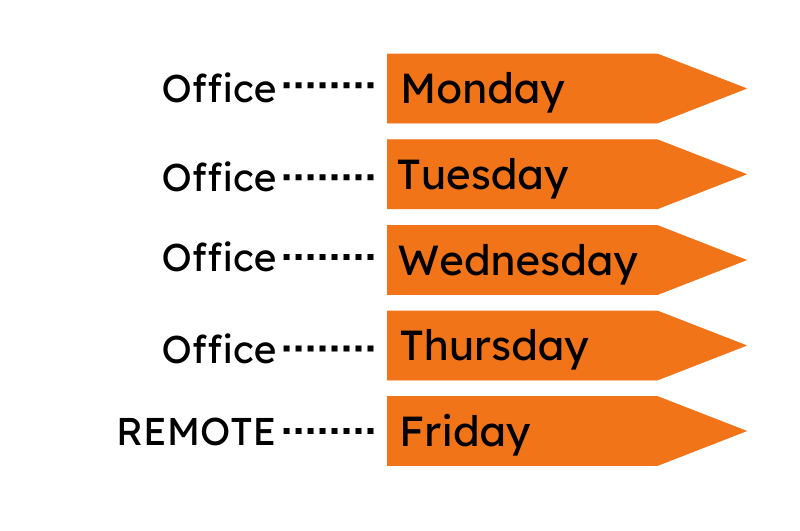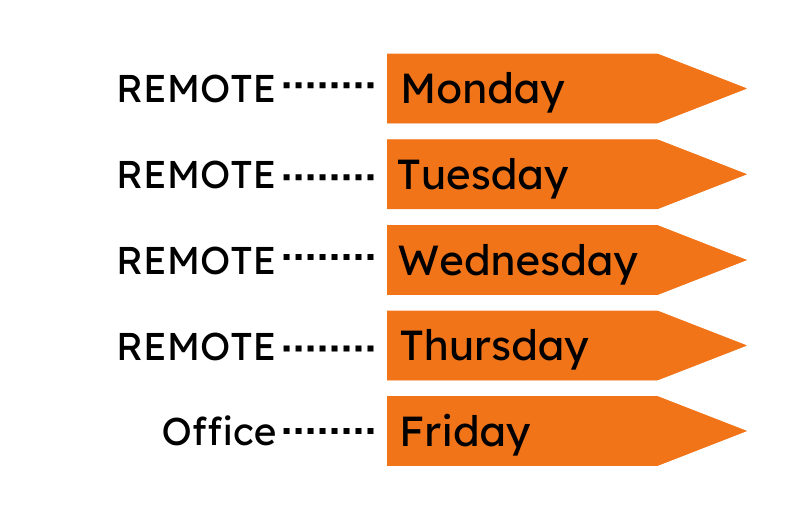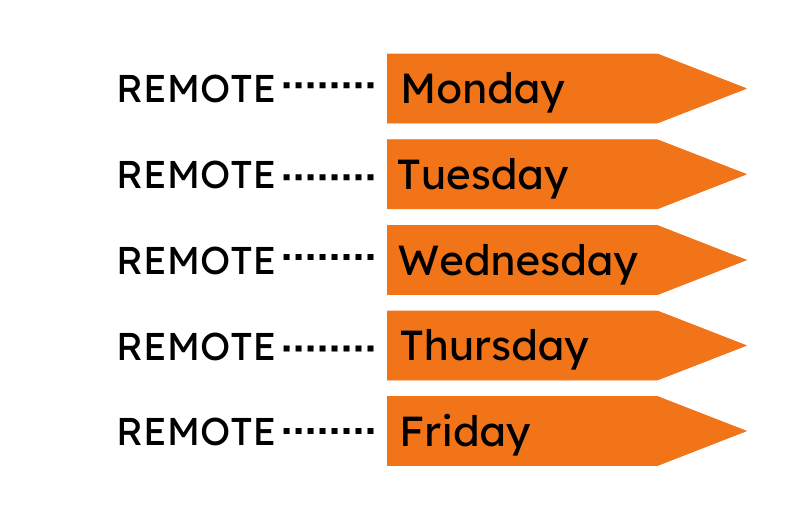As more people are transitioning to working from home, many unique work models are emerging that make this process easier and more enjoyable. You can often choose which of these work-from-home models makes the most sense for you to improve your work-life balance.
Let’s break down the types of work models available, including seven different hybrid work model examples to consider. You deserve to have the work environment that suits you, and we can help you choose the option that feels the most comfortable for your lifestyle! These ideas work for people with varying styles of time management.
What is Work From Home Models?
Work-from-home models are the setup between you and your employer that lets you work from home part- or full-time. Some hybrid work models include spending some time at home and most of it in the office, equally splitting time between the two, or working at home completely every day.
The work-from-home hybrid work model that you choose will vary based on your needs. For example, you may prefer primarily working in the office because you can focus more easily and love spending time with your co-workers. Or you might need to work fully remotely to take care of your children as you work.
This diversity in types of work models provides just about everybody with a unique experience. Some people (such as managers) may work entirely at home, while more hands-on employees (such as secretaries) may spend most of their time in an office. Choosing your work-from-home models requires matching your routine with a model’s overall design.
7 Work From Home Models You Have to Try
The following seven work-from-home models are the most popular options and should work well for many situations. For example, some provide benefits for office-based workers, while others may work better for a wide-ranging entrepreneur who needs tight time management.
1. Office-First Hybrid Work Model

The office-first hybrid work model usually puts you in the office and lets you work remotely occasionally. You typically work in the office almost daily and get one or two days per week or month to work from home. Models like these can be beneficial in many situations and for many people by letting you choose when you work from home and when you don’t.
The office first model lets people who enjoy working from the office get an occasional break to refresh their minds at home or try something different. Interestingly, many people work just as well from home as they do in the office. For example, one study found that 40% of people found working from home improved their productivity.
Pros:
- It lets you take a break from the office when needed
- Give you plenty of office time to improve socialization
- Provides remote days when needed
Cons:
- Remote day availability may vary
- You may need to schedule remote days ahead of time
2. Partly Remote Model

The partly remote work model includes teams that are fully remote and others that are in the office. Recent studies find that nearly 43% of all workers are currently in this model. Depending on your role, you might work entirely remotely, in the office, or even partially remotely. Depending on your employment, you may be flexible in choosing this option.
You may choose whether you set up an office at home to work full time or come to the office a few times per week to check in with your co-workers. One nice thing about this option is that your company may create “remote hubs” where your team can work together from time to time. These hubs may include home environments or even small rented office spaces where you can work.
Pros:
- It gives you more work possibilities
- It can help focus your team in one location
- Provides the most diverse operating options
Cons:
- It may create some confusion between departments
- This may create conflict between office workers and remote workers
3. Flexible Hybrid Model

The flexible hybrid model is one of the most popular work-from-home models on the market. You might have some productive days working from home, you might have some unproductive ones. It lets you pick what days you want to work from the office and what days you work from home. Some companies may set some limitations on when you can use this work-from-home hybrid model, such as dictating what days you have to be at the office.
However, they may also let you do things like attend meetings remotely to stay at home as long as you want. One thing to note when working with these types of work models is that you may need a set desk at the office! Instead, you may pick a desk available during work, a method known as “hot desking,” which may confuse some.
Pros:
- It gives you autonomy to choose your work environment
- Produces higher efficiency by encouraging cooperation
- It lets you work in an environment that you enjoy
Cons:
- Some remote-first employees may struggle
- Can cause empty offices
4. Remote-First Model

In a recent study by polling group Prodoscore, it was found that remote employees during the early part of the COVID-19 pandemic didn’t suffer from productivity loss. They stated: “The common assumption is that remote workers are less productive than those in a traditional office. But our ability to capture, integrate, and analyze workplace data shows otherwise.”
Many people seeing this success worked in a remote-first model, which asks employees to work primarily from home but also come to the office. You may come to the office just for a weekly work meeting or a few days a month to check in or collaborate with others. This option works best if you live close to your office and can travel there easily.
Pros:
- Creates more work opportunities for many employees
- Reduces overhead and travel costs
- It lets you interact with your team more easily
Cons:
- This can create some loneliness for remote workers
- Could cause resentment from fully office-bound employees
5. Fully remote

The fully remote model will likely become the most popular of all the work-from-home models. It eliminates any office time and puts you full-time at home. Facebook creator Mark Zuckerberg said of this model: “Working remotely has given me more space for long-term thinking and helped me spend more time with my family, which has made me happier and more productive at work.”
Zuckerberg has promised to make all Facebook employees remote soon, and a fully remote work model will likely become more and more common. These jobs let people live, tackle tasks, and care for their home life more easily. For example, you may find it easier to take care of your children working remotely.
Pros:
- Cuts back on your commute time to and from work
- It saves you money on food, childcare, and more
- It lets you set your schedule however you want
Cons:
- It may become lonely for many
- Distractions may make it harder to stay focused
6. Freelance Work Model
The freelance work model is the same as the employees working remotely but lacks a full-time employer. Instead, you find paying gigs with multiple teams or work freelance for one. This working model is becoming popular in many markets, especially in writing. As wildly popular author Stephen King put it: “Amateurs sit and wait for inspiration. The rest of us get up and go to work.”
He means freelancer writers work hard to find gigs and satisfy customers. You’ll be able to work wherever you want, including your office or coffee shop. Some people even travel and do freelance work while on vacation, giving them diverse work environments that make this a powerful work option.
Pros:
- You can choose when you work
- Client availability expands your operating range
- Setting your work rates is easy
Cons:
- Paying your taxes every year
- Potential for no job availability
7. Choose-Your-Own-Adventure Model
This unique work model is somewhat similar to a flexible hybrid but typically asks people to stick with one model over others rather than picking and choosing. For example, you might have to decide on a hybrid model, an office-only option, or working only from home. Typically, companies offer this option when multiple methods work.
For example, you may work remotely with a company from across the country while other employees near the office work there full-time. The choices will vary based on your needs and proximity, and it often works well for people who want a set and specific work schedule.
Pros:
- Creates a predictable work environment
- It lets you work with many companies
- May increase office connectedness
Cons:
- It can lead to remote workers feeling ignored
- Minimal opportunity to change your work method
3 Time Management Tips for Any Work From Home Model
Now that you’ve read some hybrid work model examples and understand the work-from-home models that may make sense to you, it is essential to make sure you implement them improperly. The following three tips work for all work models and people with different time management styles. We suggest a few powerful time management methods you might need to learn.
1. Set Up Regular Work Meetings

Even though work meetings might seem dull to most people, they’re vitally crucial for remote workers. Setting up regular meetings lets you stay in touch with your co-workers and build stronger personal bonds. It also helps break the loneliness and isolation that some remote workers may feel. Meetings help when some people work remotely and others don’t because they build stronger and more consistent communication lines.
Just as importantly, regular meetings help you plan and execute various work tasks smoothly and efficiently. For instance, you can use daily half-hour meetings to gauge your progress on a project and report it to your team to ensure you are all on the same wavelength together.
2. Try Time Management Techniques
Integrate powerful time management concepts into your daily routine to stay on task. Pomodoro schedules your day in 25-minute work periods separated by five-minute breaks. Eat the Frog forces you to tackle tasks you may feel uncomfortable doing to ensure that you stay focused.

Likewise, working with the Time Management Matrix lets you set task urgency and importance to ensure that you don’t get distracted by simple tasks that don’t need to be done. Important tasks should always be done first, followed by urgent ones, non-urgent ones, and non-important ones.
3. Know Your Limits
While working from home may increase your productivity, you may feel compelled to work longer hours on some days to get ahead and take it easy on other days. Unfortunately, this unbalanced work schedule might create excess work fatigue that may be challenging to overcome.
Listen to your body to ensure that this doesn’t happen to you. If you feel fatigued and can’t focus, stop working or take a long break before returning to a task that day. Working from home should help you, not hinder you, so take good care of yourself to avoid these frustrations.
Conclusion
These diverse work environments let you work from home partially or full-time and create many career opportunities. As long as you take the time to understand and properly implement these options, you should be able to choose a time management style that suits your workflow. Communicating with your team can help improve this process and keep you productive.


